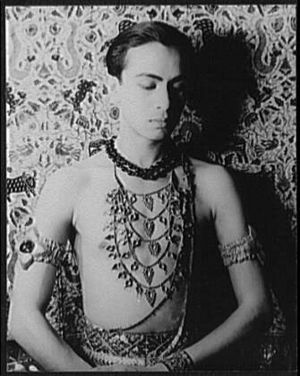Ram Gopal (dancer) facts for kids
Bissano Ram Gopal (born November 20, 1912 – died October 12, 2003) was a famous Indian dancer and choreographer. He often performed alone and traveled a lot during his long career. Ram Gopal was a modern artist who mixed traditional Indian dance with ballet steps. Along with Uday Shankar, he was one of the first people to show Indian classical dance to Western audiences starting in the 1930s. A Polish critic even called him "the Nijinsky of India," comparing him to a very famous ballet dancer.
As a choreographer, he was best known for his shows like Legend of the Taj Mahal and Dances of India. He also created a special dance called "Radha-Krishna" in 1960 with the British ballerina Alicia Markova.
Early Life and Dance Training
Ram Gopal was born in Bangalore, India. His mother was from Burma, and his father was a lawyer from the Rajput family. They lived in a large house called Torquay Castle. His grandmother was also a well-known dancer.
Ram Gopal loved dance from a young age. He learned Kathakali from teachers like Guru Kunju Kurup. One time, he danced at a party for the Maharaja of Mysore without his father's permission. But the Maharaja convinced his father to let him continue his dance training.
Later, in his early twenties, he found Guru Meenakshi Sundaram Pillai. He started learning Bharatanatyam from him, a special style called Pandanallur. He also learned Kathak and even Manipuri dance. He used all these different dance styles in his own performances over the years.
Ram Gopal's Dance Career
In the 1930s, an American dancer named La Meri invited Ram Gopal to tour with her in Asia. He performed his first solo show in New York City on May 1, 1938. In 1939, he went to Paris and then made his London debut at the Aldwych Theatre. He became famous very quickly. He even met Queen Mary and became friends with important ballet dancers.
Ram Gopal toured a lot by himself and with his dance group before and after World War II. His shows were known for their beautiful costumes, stage designs, and lighting. He performed at big festivals, including the New York Golden Anniversary International Dance Festival in 1948. He also danced at the Jacob's Pillow Festival in 1954 and the Edinburgh Festival in 1956.
In 1960, he worked with the famous ballerina Alicia Markova. They created a duet called "Radha-Krishna," based on Hindu stories. She danced as Radha, and he danced as Krishna. Today, a bronze statue of Alicia Markova stands next to a painting of Ram Gopal in the National Portrait Gallery, London. This remembers their special dance.
Ram Gopal also danced with other talented artists like Mrinalini Sarabhai and Kumudini Lakhia. A dance critic named Cyril Beaumont wrote that Ram Gopal was amazing because he could combine four different dance styles so well.
In 1950, a book called "Classical Dances and Costumes of India" was published. Ram Gopal wrote the introduction for this book. It included many photos and drawings of him performing classical dances.
He wrote his own books, Indian Dancing in 1951 and his life story, Rhythms in the Heavens, in 1957. He also opened two dance schools for a short time. One was in Bangalore, and later he opened the "Academy of Indian Dance and Music" in London in 1962. In his later years, he lived in London, Venice, and the South of France.
Filmmakers also made movies about him. Claude Lamorisse made "Aum Shiva" and "Ram." Sarah Erulkar, a British filmmaker, featured him in her short film Lord Siva Danced (1947).
Ram Gopal received important awards for his work in dance. In 1999, he was given the Order of the British Empire (OBE). In 1990, he received the Sangeet Natak Akademi Fellowship from India's National Academy for Music, Dance and Drama.
Later Life
In the 1960s, while living in Chelsea, London, Ram Gopal was briefly married to Edith Alexander. They did not have any children.
He passed away in a care home in Croydon, South London, UK. He had spent his last three years there. After he was cremated, his ashes were scattered at the home of the Lamorisse family in the South of France. Pam Cullen, a close friend of Ram Gopal, became in charge of his belongings. She gave some of his dance costumes, especially his fancy headpieces, to the V&A Museum in London.
Works
- Indian dancing, by Ram Gopal, Serozh Dadachanji. Phoenix House, 1951.
- Ram Gopal: rhythm in the heavens : an autobiography, by Ram Gopal. Secker and Warburg, 1957.


